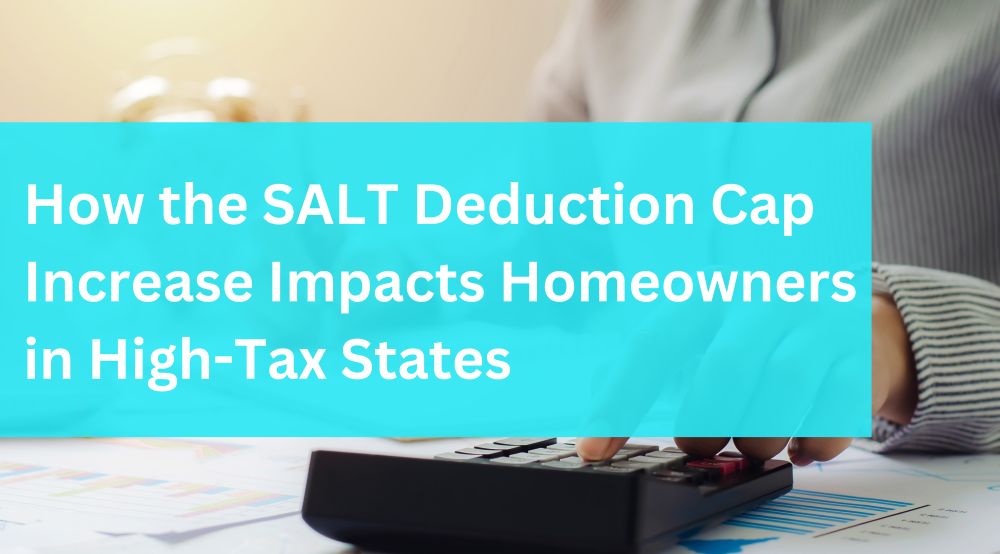If you own property or pay significant state taxes in places like California, New York, or Arizona, there’s some encouraging news in the latest tax reform bill. Starting in 2025, the State and Local Tax (SALT) deduction cap will increase, bringing long-awaited relief to homeowners in high-tax regions.
Here’s what the SALT deduction is, what’s changing, and how it can affect your bottom line, especially if you own real estate or are planning to buy.
💡 What Is the SALT Deduction?
The State and Local Tax (SALT) deduction allows taxpayers to deduct certain taxes they pay to state and local governments—typically income, sales, and property taxes—from their federal taxable income.
In 2018, the Tax Cuts and Jobs Act placed a hard cap of $10,000 on this deduction. That meant even if you paid far more in state income or property taxes, only the first $10,000 could be deducted on your federal return.
For residents of high-tax states, this cap significantly increased federal tax liability—especially for middle- and upper-middle-class households. It also removed some of the financial benefits of homeownership in expensive housing markets.
🔁 What’s Changing Under the New Law?
Beginning in 2025, the SALT deduction cap will increase from $10,000 to $40,000 annually for households earning under $500,000.
This expanded cap is temporary and will apply from 2025 through 2029, phasing down gradually after that. However, during this window, eligible households will be able to deduct much more of their property, income, and local taxes—providing meaningful tax relief.
🌆 Why This Matters—Especially in High-Tax States
1. You Can Deduct More of What You Already Pay
If you're paying $20,000+ annually in state income taxes and property taxes (which is common in California and New York), you’ve likely been frustrated by the $10,000 cap. Now, you’ll be able to deduct up to $40,000—a fourfold increase.
This reduces your taxable income and, depending on your tax bracket, could lower your federal tax bill by thousands of dollars per year.
2. Restores Tax Fairness for Middle-Income Earners in High-Cost Areas
Many homeowners in high-tax states have felt penalized by the previous SALT cap, even if their incomes weren’t considered “wealthy.” Raising the cap specifically for those earning under $500,000 restores a sense of fairness by recognizing regional cost-of-living differences.
Now, more middle-income families can access the full benefit of this deduction—without relocating to lower-tax states.
3. It Offsets the Rising Costs of Homeownership
From increasing mortgage rates to elevated insurance premiums and property taxes, owning a home has become more expensive. This updated SALT deduction offers a much-needed break that can make staying in your home—or buying one—more financially viable.
🔎 Who Qualifies for the Increased SALT Deduction?
To benefit from the expanded SALT deduction, you must meet the following criteria:
Household income must be under $500,000
You must itemize deductions on your federal tax return
You must pay state income and/or property taxes (or local sales taxes in states without income tax)
The expanded deduction applies only from 2025 through 2029
If you typically take the standard deduction, you may not benefit from the SALT cap increase unless your itemized deductions (including mortgage interest and charitable giving) surpass that threshold.
📍 Example: How This Could Impact a California Homeowner
Let’s say you live in San Diego and earn $225,000 a year. Between state income taxes and property taxes on your $900,000 home, you’re paying roughly $28,000 annually in SALT taxes.
Under the previous $10,000 cap, only a portion of that was deductible.
Under the new $40,000 cap, you can now deduct the full $28,000—reducing your taxable income by an additional $18,000. If you’re in the 24% tax bracket, that could mean over $4,000 in federal tax savings annually.
⏳ Temporary Relief, Long-Term Strategy
While the SALT cap increase is not permanent, it provides a critical window of opportunity between 2025 and 2029. Homeowners, buyers, and real estate investors should factor this into their mid-term financial planning.
This change may also influence decisions about buying, selling, or holding property in high-tax states during that period. Strategic tax planning can help you take full advantage before the cap reverts or phases down.
🧭 Final Thoughts: Stay Informed, Stay Ahead
Regardless of your political views on tax reform, it’s essential to understand how policy changes affect your personal finances. The expanded SALT deduction cap offers meaningful tax relief for millions of homeowners—particularly in high-cost, high-tax regions.
If you’re unsure how this change applies to your situation, now is a good time to consult with your tax advisor or financial planner.
Need Help Planning Your Next Move?
At Beyond Property Management, we understand how taxes and housing policy intersect. Whether you're buying, investing, or just trying to keep more of what you earn, we help you make smart, informed decisions with your real estate.






